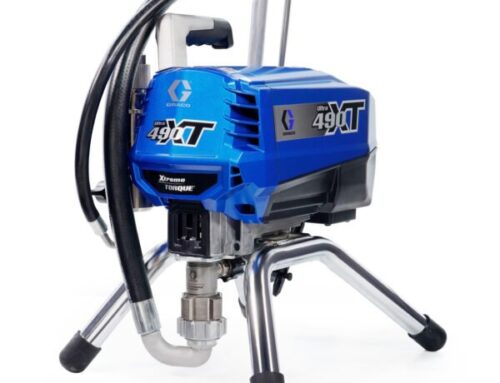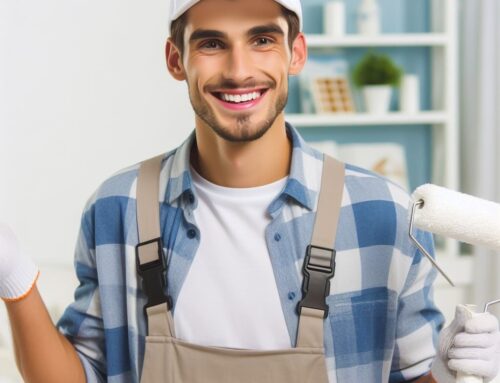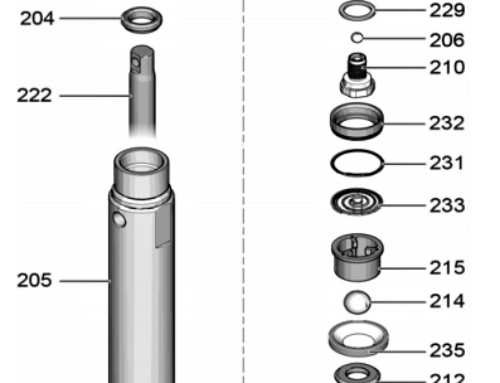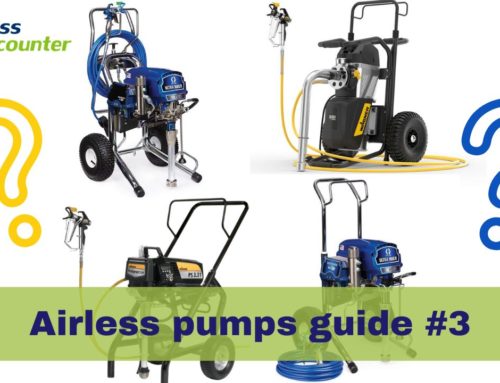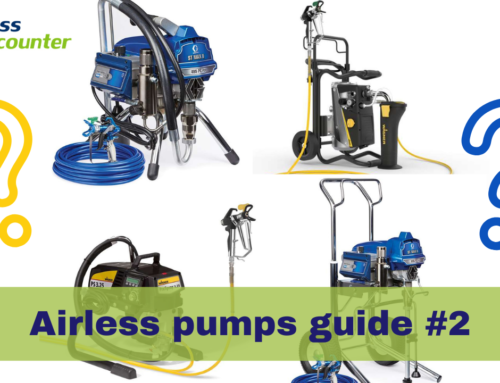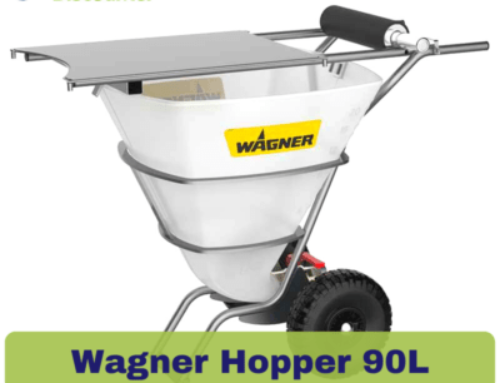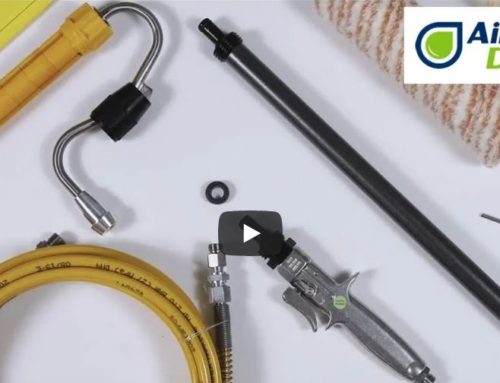Learn how AirCoat spraying differs from traditional Airless spraying; the primary areas of application and other possible applications of using the AirCoat spraying technique, as well as the design and function of AirCoat sprayers.
In addition, we look at the pros and cons of AirCoat spraying and give some tips for the selection and conversion of paint spraying devices into air-assisted systems.
What is an AirCoat paint sprayer?
AirCoat spraying is an air-assisted airless spraying process. This means the Airless spraying system is used in conjunction with a second system supplying air and influencing the spray of the material.
Based on the Airless spraying technique whereby paint or other materials (lacquer, primer, plaster etc) are pressurized in a diaphragm or piston pump and sent through a high-pressure hose, feeding the material to the gun and atomized at the nozzle; with air-assisted Airless spraying, air is also supplied to the gun.
This air is provided by a compressor and directed to the gun via a second hose. There, the air is distributed over the air cap and surrounds the jet of paint with an air jacket (see drawing).

Wagner AirCoat – How does it work?
AirCoat technology enables the spraying of paints and other material coatings with less pressure. This creates a particularly soft atomization and a very fine spray fan pattern. For this reason Aircoat paint sprayers are especially useful when wanting to achieve high quality surface finishes. Application examples can be found in furniture and exhibition construction, in the preparation and painting of window frames and doors and generally in the area of wood- and steel furniture and construction.
Further arguments in favor of using an AirCoat paint sprayer are: high spraying efficiency, the reduced overspray, the lower material consumption and the additional adjustment options on the Aircoat gun. Aircoat sprayers are particularly suitable for low-viscosity materials, i.e. relatively thin products such as paints or glazes. For thicker and higher viscosity materials, the use of an AirCoat device is less suitable. In this case, the Airless method would be a better option.
The term “AirCoat” is used by the manufacturer Wagner and is legally protected. Other manufacturers refer to the AirCoat process as AirCombi or air-assisted spraying.
For which paint materials and painting applications would Aircoat spraying be most suitable?
AirCoat spray guns are particularly suitable for spraying lacquers and glazes. With these materials you can achieve especially high quality surface finishes. That’s why AirCoat paint sprayers are used on doors, window shutters and door- and window frame construction. Carpenters, steel- and exhibition builders are also increasingly relying on AirCoat spraying technology.
Both 1K and 2K materials can be processed. For the processing of two-component materials, it is important to observe and comply with the dripping-time to prevent the paint from drying out in the sprayer, hose or gun. Both water-based and solvent-based paints and coatings can be processed.
How is an AirCoat paint sprayer constructed?
The most important components that comprise an AirCoat spraying system is the airless sprayer, the compressor, the air supply pressure regulator, the dual hose consisting of a paint- and air hose and the AirCoat gun with air cap and AirCoat nozzle.
Sprayer – the base for AirCoat spraying
To put the paint under pressure, a classic Airless sprayer is used. Different equipment variants are possible here, compressed air-operated sprayers as well as paint sprayers with electric drive pumps are used. Depending on the area of application, there are advantages and disadvantages of electric- or air-driven models, which must be taken into account when selecting the right AirCoat sprayer.
For example, in the areas requiring explosion-protection, a compressed air-operated pump offers a safer alternative to the electric spraying device, because an electric motor can generate sparks during operation. Risk of explosion increases dramatically if, for example, solvent-based paints with a low flash point are processed.
Other factors to consider when choosing between an electric and air-driven AirCoat sprayer include: the performance of the existing compressor, noise from the compressor, weight and mobility of the sprayer and compressor, and explosion and fire safety requirements of the working site.

Construction of a membrane pump – Airless paint sprayer
In addition to the options for driving the sprayer, there are also options for selecting the pump. Both membrane and piston pumps can be used in aircoat spraying. Both pump versions are available in the market both with electric drive and with compressed air.
A detailed overview of the advantages and disadvantages of diaphragm and piston pumps can be found in the article “What’s better – diaphragm or piston pump as Airless paint sprayer?“.
Using a compressor for AirCoat spraying
The compressor generates the necessary air pressure to supply the gun with additional air. When using compressed air-operated pumps, the compressor also supplies the drive of the spray unit with compressed air. It is important that sufficient power is provided by the compressor.
This means that the compressor has to generate enough air volume per minute to supply compressed air to the gun and/or the sprayer as needed.
Weight and volume are also important factors in the selection of the compressor. Especially when transporting to, from and around construction sites, these factors affect mobility and noise pollution.
Pressure control unit for the regulation of compressed air in Aircoat paint sprayers
The air supply from the compressor to the gun can be precisely controlled via the pressure control unit. On one side of the air hose the compressor is connected. On the other side, the air hose is screwed between the control valve and the gun. A manometer displays the current air pressure readings.
Through a valve, the air supply can be increased or reduced by rotating the valve knob.

Wagner SF 23 Plus AirCoat with compressed air regulator
Double hose consisting of a paint- and air hose for AirCoat sprayers
The double hose of an AirCoat paint sprayer consists of a paint hose and an air hose. Using the paint hose, the paint or other material is passed from the sprayer under high pressure to the AirCoat gun. Parallel to the paint hose, the air hose runs. In the air hose, the air is coming from the compressor, forced through the pressure control valve to the gun.
The compressed air, in most cases, travels through the air hose with a maximum pressure of 8 bar. In most applications, however, the air pressure is much lower. Therefore, make sure that the paint- and air hose are not reversed. As a rule (but not always) different threads on the paint- and air hose are used to avoid confusion.

Double hose for AirCoat & air-assisted Airless spraying
AirCoat gun with air cap and AirCoat nozzle
The AirCoat spray gun distributes and applies the paint or varnish. With a pull of the trigger on the gun, the material can be released. In addition, most AirCoat guns have the ability to control the distribution of the supplied compressed air.
A filter in the spray gun protects the nozzles from clogging. The air cap determines the air flow and the AirCoat nozzle at the tip of the gun provides atomization of the paint.

Wagner GM 4600 AirCoat gun
How does an AirCoat sprayer work?
A membrane- or piston pump pressurizes the material (lacquer, paint, primer,, plaster etc) using the classic Airless method. That is, the material is compressed without the supply of air by the pressure of the piston or the membrane pump. The sprayer generates a maximum pressure of 250 bar. As a rule, work is carried out below this pressure range (exceptions exist for applications in the industrial sector).
The material is pumped to the gun via a high-pressure hose. When the trigger of the AirCoat gun is actuated, the material moves through the gun filter and at the nozzle the material is atomized. At the same time, the compressor generates compressed air, which is conveyed through the air hose parallel to the paint hose to the gun. Between the compressor and the gun sits the pressure control valve.
Through this valve, the amount of air supply and the pressure can be controlled. The compressed air is guided through the gun to the air cap and thus circulates around the paint jet. The air supply can also be controlled by the gun.
Advantages of the AirCoat spray process
- high surface quality
- high area performance and working speed
- soft spray pattern
- reduced overspray
- low material consumption at 70 to 75% efficiency
- suitable for low-viscosity materials such as lacquers and glazes
Disadvantages of the AirCoat spraying process
- less suitable for high viscosity materials
- less suitable for processing very small quantities of material
Which AirCoat sprayer is right for my projects?
There are several factors to consider when choosing the right AirCoat paint sprayer. That’s why we have summarized the key points here to avoid the biggest stumbling blocks and poor decisions when purchasing a sprayer.
In addition, we present an example of some models that could be suitable for your projects. But first the essential points to consider when buying an AirCoat paint sprayer.
- Performance of the sprayer
- Power of the compressor
- Drive – electric or compressed air operated
- Diaphragm or piston pump
- Intake – directly from the container or funnel
- Weight and transport
- Budget and price
An overview of the popular AirCoat paint sprayers
Here is an overview of some of the most common AirCoat sprayers.
Wagner SF 23 Plus on trolley with AirCoat equipment
The Wagner SuperFinish 23 Plus is an electric diaphragm pump with a delivery rate of 2.6 l / min and a weight of 29 kg. The maximum working pressure is 250 bar and nozzles can be used up to a bore size of 0.023″.
The model is suitable for mobile use, as it can be easily transported. That is why it is often used by trade fair builders and mobile carpenters. A customer has recently opted for this model because he had an order to paint the doors of an old school. Since the school grounds were fairly large, he was quite happy the device was so mobile due to the trolley and could easily move the device from one door to the next in the school building.
This model is equipped with a 5-liter funnel, in which the paint can be easily filled. But there is also the possibility to provide the model with a suction pipe to process the paint directly from the bulk container.
In addition, there are some other equipment options, such as the floor standing unit without wheels or another model on which the compressor for compressed air supply is installed on the same machine.
Wagner Puma 28-40 – air-driven piston pump in AirCoat equipment
The Wagner Puma 28-40 is a compressed air driven piston pump with a gear ratio of 28: 1. If compressed air is supplied with a bar pressure, the air motor generates a material pressure of 28 bar.
The maximum air inlet pressure is 8 bar, resulting in a maximum material pressure of 224 bar. Also this model is available in different equipment variants. In addition to the four-legged stand unit (see picture), the manufacturer offers a variant on a trolley and a model for fixed wall mounting.
In the intake area there are also options. The figure shows the Puma 28-40 with a rigid intake system.
Thus, the paint or the lacquer can be processed directly from the container. Another option is a suction hose. For small amounts of material, the 5-liter funnel can also be mounted.
Wagner Cobra 40-10 – compressed air driven diaphragm pump in AirCoat equipment
The Cobra 40-10 is a compressed air diaphragm pump and is especially popular with stationary operators. The Aircoat unit has a maximum flow rate of 2.0 l / min and produces a maximum working pressure of 250 bar.
Due to the pneumatic drive, this model, like the Puma 28-40, is suitable for operation in explosion-proof areas. For this purpose, a grounding cable is included. The material is suctioned via the 5-liter material container.
Conversion of classic airless devices to the AirCoat sprayer
With an AirCoat gun, a double hose and a compressed air regulator, many classic Airless machines can be converted into an AirCoat sprayer. The exact procedure and the required components, are summarized in the article “Is the conversion of an Airless paint sprayer to an AirCoat / air-assisted airless possible?” and documented in the video below.
Love our content? You can find more here:
Visit our Facebook page
Check out our Airless Discounter YouTube channel
Airless Discounter Instagram account
Questions or queries?
For any further questions or if you would like to get your hands on one of these products seen in this article, you can contact us on +49 30 220 15436, fill out our contact form below or email us. If you wish to purchase one of the products mentioned above, you can check them out in our online store. You can also visit us at our service base during office hours.




